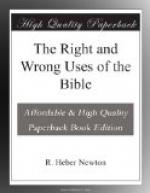But, when this knowledge is won and duly employed in our theologizings, the truest use of the Bible remains for us to make, to our highest pleasure and profit. It is the book of religion, not of theology; save as it records the one authoritative Epistle of Theology, the Word of God, the Christ. It is not a body of divinity, it is the soul of divinity. To use the Bible critically and historically for our theologizings, is, after all, to use it, however rightly, for its secondary and not its primary purpose. Religion—as the awed sense of the Eternal Power and Order revealed in nature, the Infinite Goodness and Righteousness revealed in man—is the art of the soul; its finest feelings, its loftiest imaginations, its noblest enthusiasms its profoundest tragedies thrown out into the cry of the human after God.
There is a science in the sculptor’s art. It is doubtless needful that this art should be studied for the sake of its science. Artists, however, may be glad that Winckelmann has analyzed the Apollo Belvedere, and has given them the laws of proportion deduced from this human form divine; leaving them free to feast upon its beauty. For in the scientific study of art, art itself may be lost. Some great figure-painters have been unwilling that their pupils should study anatomy; fearing that the bones would stick through the flesh in their paintings.
This danger shows itself plainly in all critical and historical uses of the Bible, in the old-fashioned as in the new-fashioned study of the Bible.
The international series of Sunday-school lessons burden the brief hours of the Lord’s Day with a mass of matter, which may or may not be true knowledge about the Bible, but which certainly is not the true religion of the Bible. A child may learn the tables of the Israelitish Kings, the geography of the Holy Land, and the architect’s plans of the temple of Jerusalem, and may be learning nothing whatever of the real religion which is shrined within the Bible. That is very simple:
Thou shalt love the Lord thy God
with all thy heart, and with all thy
mind, and with all thy strength:
And thy neighbor as thyself.
The time spent on these more or less interesting matters may rob the child of his one weekly opportunity of learning to use the Holy Scriptures so as to become wise unto salvation. To use their words of wise men, and their tales of holy men, to inspire the love of goodness as the love of God, this and this alone is to teach religion from the Bible. Bread that consists of two-thirds bran and one-third white flour is eminently laxative; but it is generally supposed that this age is lax enough in its hold of truth. A little more wheat and a little less bran, ye good doctors, might strengthen the constitutions of our children.
The new study of the Bible is perhaps even more in danger of missing its real secret. An interest in the literature and history of Israel may divert the mind from that which is, after all, the heart of these “letters,” and the core of this history.




